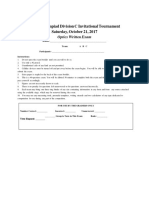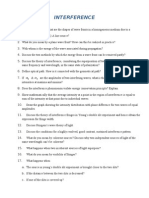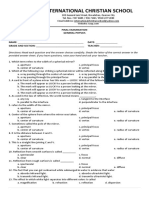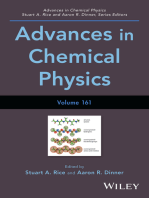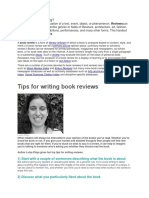Tutorial 11 - Q
Uploaded by
azm syqiTutorial 11 - Q
Uploaded by
azm syqiPHY098
CENTRE OF FOUNDATION STUDIES UiTM
23/24
SERWAY VUILLE, COLLEGE PHYSICS, 11TH EDITION
TUTORIAL 11 – Chapter 22.1 – 22.4, 22.7, 23.3 – 23.5
Multiple-Choice Questions (MCQ)
1. Index of refraction is defined as
A. the ratio of speed of sound in air to speed of sound in a medium
B. the ratio of speed of light in vacuum to speed of light in a medium.
C. the ratio of speed of light in a medium to speed of light in vacuum.
D. the ratio of speed of sound in a medium to speed of sound in air.
2. Absolute refractive index of any medium is always _______.
A. less than 1 (<1)
B. 0
C. 1
D. greater than 1 (>1)
3. Choose the most accurate answer.
Total internal reflection occurs when _______.
A. there is a change in the speed of light travels in the medium.
B. there is change in temperature of two medium encounter by the light.
C. when light attempts to travel from a medium with higher index of refraction to a lower
index of refraction.
D. when light attempts to travel from a medium with lower index of refraction to a higher
index of refraction.
4. Critical angle is ……
A. an angle of incidence that will result in angle of refraction of 45o
B. an angle of refraction that is incident by a 90o light rays.
C. an angle of incidence that will result in angle of refraction of 90o
D. an angle of refraction that is incident by a 45o light rays.
5. Snell’s law of refraction describes ….
A. the amount of bending light rays which depends on the indices of refraction of two
medium.
B. the amount of absorbed light rays which depends on the indices of refraction of two
medium.
C. the index of refraction of the incident medium.
D. the index of refraction of the second medium.
Prepared by Pn A’bir Wardati, Dr Fadiatul Hasinah, Dr Hartini, Pn Nur’Ain. 1
PHY098
CENTRE OF FOUNDATION STUDIES UiTM
23/24
6. Choose the correct statement:
A. The speed of light increases as the light travels from low dense medium to a high dense
medium.
B. The higher the index of refraction of a medium, the lower the density of the medium.
C. The speed of light decreases as the light travels from low dense medium to a high dense
medium.
D. The lower the index of refraction of a medium, the higher the density of the medium.
7. Is it possible to have total internal reflection for light incident from air to water? Explain.
A. Yes. Because the light rays will refract away when it travels from air to water.
B. No. Because the light rays will refract away when it travels from air to water.
C. Yes. Because the speed of light is higher in the air than in the water. Thus, the light rays
will refract away when it travels from air to water.
D. No. Because the speed of light is higher in the air than in the water. Thus, the light rays
will refract towards the normal line when it travels from air to water.
Structured Questions
Chapter 22.1 – 22.4, 22.7
1. A laser beam is incident at an angle of 30.0o to the vertical onto a solution of corn syrup in
water. If the beam is refracted to 19.24o to the vertical, (a) what is the index of refraction
of the syrup solution? Suppose the light is red with a wavelength of 632.8 nm in a vacuum.
Find its (b) wavelength (c) frequency and (d) speed in the solution.
Answer: (a) 1.52, (b) 416 nm, (c) 4.74 x1014 Hz, (d) 1.97 x 108 m/s
2. Determine the maximum angle θ for which the light rays incident on the end of the light
pipe in Figure 1 are subject to total internal reflection along the walls of the pipe. Assume
the light pipe has an index of refraction of 1.36 and the outside medium is air.
Figure 1
Answer: 67.3o
3. A beam of light is incident from air on the surface of a liquid. If the angle of incidence is
30.0° and the angle of refraction is 22.0°, find the critical angle for the liquid when
surrounded by air.
Answer: 48.5o
Chapter 23.3-23.5
4. An object is located 20.0 cm to the left of a diverging lens having a focal length -32cm.
Determine (a) the location and (b) the magnification of the image. (c) Construct a ray
diagram for this arrangement.
Answer: (a) 12.3 cm to the left of the lens, (b) +0.615
Prepared by Pn A’bir Wardati, Dr Fadiatul Hasinah, Dr Hartini, Pn Nur’Ain. 2
PHY098
CENTRE OF FOUNDATION STUDIES UiTM
23/24
Additional Questions
1. A ray of sunlight is incident at 30 on a water surface as shown in Figure 2 below. Given
the refractive index of water is 1.33.
Figure 2
(a) Determine the angle at which the ray is refracted.
(b) If the ray of sunlight is incident at the same angle on a block of glass surface instead
of water surface, does the refracted ray bend closer or away from the normal surface?
Given the refractive index of the glass block is 1.50.
Answer: (a) 40.6o
2. An object is a distance f/2 from a converging lens.
(a) Use a ray diagram to find the approximate location of the image.
(b) is the image upright or inverted?
(c) is the image real or virtual?
3. An object is placed 10 cm from a converging lens. The converging lens has a focal length
of 15 cm.
(a) Using the lens equation to determine the image position.
(b) Calculate the magnification of the image produced.
Answer: (a) -30 cm, (b) +3
Prepared by Pn A’bir Wardati, Dr Fadiatul Hasinah, Dr Hartini, Pn Nur’Ain. 3
You might also like
- Brian Tracy No Excuses Power of Self-Discipline100% (1)Brian Tracy No Excuses Power of Self-Discipline4 pages
- EducationFreedomScholarships Amd - SB2787No ratings yetEducationFreedomScholarships Amd - SB27877 pages
- The Physics and Technology of Diagnostic Ultrasound: Study Guide (Second Edition)From EverandThe Physics and Technology of Diagnostic Ultrasound: Study Guide (Second Edition)No ratings yet
- River Dale High School, A'Bad: PA-II ExaminationNo ratings yetRiver Dale High School, A'Bad: PA-II Examination5 pages
- A+ Blog-Std 9-Physics-Chapter-1-Practice Questions (Em)No ratings yetA+ Blog-Std 9-Physics-Chapter-1-Practice Questions (Em)6 pages
- Class Xii Physics Exemplar Solution Chapter 10 - Wave OpticsNo ratings yetClass Xii Physics Exemplar Solution Chapter 10 - Wave Optics39 pages
- 12 ISC, Physics, Prelim 2, Optics, 24-Dec-17, PodarNo ratings yet12 ISC, Physics, Prelim 2, Optics, 24-Dec-17, Podar3 pages
- Physics Project On Total Internal ReflectionNo ratings yetPhysics Project On Total Internal Reflection8 pages
- PHYSICS - PROJECT - FINAL by K BharadwajNo ratings yetPHYSICS - PROJECT - FINAL by K Bharadwaj13 pages
- 9936858-Class 12 - Physics - Wave Optics - Ws With Ans - AnuNo ratings yet9936858-Class 12 - Physics - Wave Optics - Ws With Ans - Anu14 pages
- TUTORIAL 7 - Chapter 19.7 - 19.9, 20.1 - 20.2: Conceptual & Multiple-Choice Questions (MCQ)No ratings yetTUTORIAL 7 - Chapter 19.7 - 19.9, 20.1 - 20.2: Conceptual & Multiple-Choice Questions (MCQ)5 pages
- s.5 Physics 2 Bot2.203 Doc (84) Revision Past PapersNo ratings yets.5 Physics 2 Bot2.203 Doc (84) Revision Past Papers4 pages
- Examples of Subjective and Objective Questions in Biophysics (1)No ratings yetExamples of Subjective and Objective Questions in Biophysics (1)7 pages
- Examen FInal - AVET245 - 2023 - EstudiantesNo ratings yetExamen FInal - AVET245 - 2023 - Estudiantes8 pages
- Physics Important Questions for Class 12th 9 and 10No ratings yetPhysics Important Questions for Class 12th 9 and 1035 pages
- Bending Strength of High-Density Fibreboards (HDF) Manufactured From Wood of Hard Broadleaved SpeciesNo ratings yetBending Strength of High-Density Fibreboards (HDF) Manufactured From Wood of Hard Broadleaved Species14 pages
- Larsen-Freeman On Teaching Methods and Approaches For Teaching English As A Foreign LanguageNo ratings yetLarsen-Freeman On Teaching Methods and Approaches For Teaching English As A Foreign Language15 pages
- AILET, 2018 - First Merit List of Selected CandidatesNo ratings yetAILET, 2018 - First Merit List of Selected Candidates6 pages
- Skillslash Digital Marketing Master Course With Gen-AiNo ratings yetSkillslash Digital Marketing Master Course With Gen-Ai17 pages
- My Enemy'S Enemy Is My Friend: It Makes Sense To Assume That, All OtherNo ratings yetMy Enemy'S Enemy Is My Friend: It Makes Sense To Assume That, All Other5 pages
- General Organic Chemistry - JEE Main 2020 JanuaryNo ratings yetGeneral Organic Chemistry - JEE Main 2020 January5 pages
- Application Checklist: (Please Tick For Documents Submitted)No ratings yetApplication Checklist: (Please Tick For Documents Submitted)2 pages
- Reading The Most Dangerous Game by Harold Brodkey: Robert Jan M. ReyesNo ratings yetReading The Most Dangerous Game by Harold Brodkey: Robert Jan M. Reyes8 pages
- Pap Certification of Psychology Specialists Primer PDFNo ratings yetPap Certification of Psychology Specialists Primer PDF19 pages
- Create Tests in The Open Source Tool TCExamNo ratings yetCreate Tests in The Open Source Tool TCExam5 pages
- Wang CSPNet A New Backbone That Can Enhance Learning Capability of CVPRW 2020 PaperNo ratings yetWang CSPNet A New Backbone That Can Enhance Learning Capability of CVPRW 2020 Paper10 pages




















